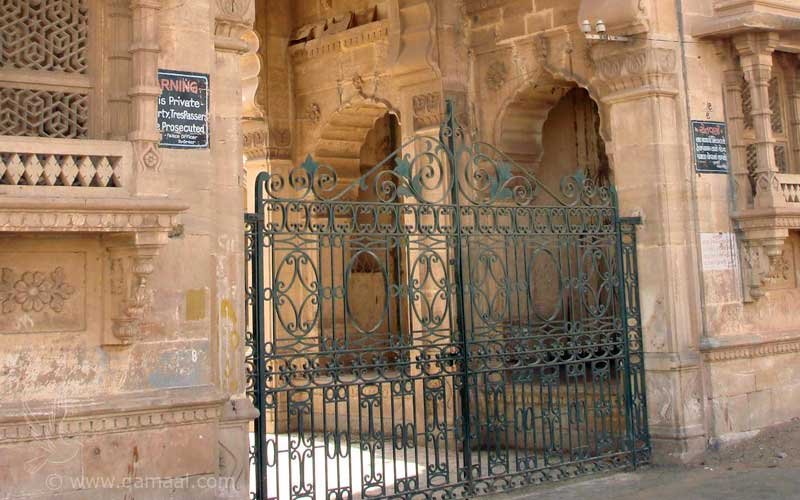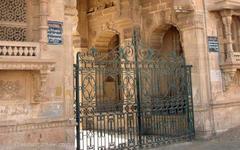
Darbargadh No Tamrapatro Visiting Hours, Tickets & Morbi Historical Sites: Complete Visitor Guide
Date: 14/06/2025
Introduction
Darbargadh No Tamrapatro, majestically perched on the banks of the Machchhu River in Morbi, Gujarat, stands as a living testament to the city’s royal legacy and architectural excellence. Once the seat of the Jadeja Rajput dynasty, this historic palace—translating to “Copper Plate of the Royal Court”—was the administrative and cultural heart of the region. Today, it invites visitors to immerse themselves in centuries of history, exquisite architecture, and vibrant local traditions. Whether you’re a history enthusiast, architecture lover, or cultural explorer, this guide offers everything you need to plan a memorable visit to Darbargadh No Tamrapatro and the surrounding historical sites of Morbi.
For the most up-to-date information, ticket bookings, and guided tours, consult the official Morbi tourism website and the Audiala app.
Table of Contents
- Introduction
- Historical Background and Significance
- Architectural Marvels
- Political & Cultural Role
- Visiting Hours, Tickets, and Accessibility
- How to Get There
- Nearby Attractions
- Festivals, Events & Local Culture
- Practical Visitor Tips
- Frequently Asked Questions (FAQ)
- Visuals and Interactive Resources
- Summary and Visitor Recommendations
- Sources and Further Information
Historical Background and Significance
Darbargadh No Tamrapatro’s roots trace back to the 17th century, symbolizing the power of the Jadeja Rajput rulers who shaped Morbi’s destiny (morbi.nic.in). The palace’s name reflects its central role in governance: royal decrees were historically recorded on copper plates, signifying authority and legal power. The oldest surviving structures were built around 1885 under HH Shri Waghji Rawaji Thakore, whose vision transformed Morbi into a progressive princely state (morbimitra.com). Over time, the palace evolved into a center for both political administration and cultural festivities, witnessing pivotal moments in regional and national history.
Architectural Marvels
Layout and Style
Darbargadh No Tamrapatro is a harmonious blend of Rajput valor, Mughal artistry, and European refinement (travelsbliss.com). Its design features:
- Grand Gateways & Bastions: Intricately carved entrances and robust bastions set a regal tone.
- Marble Galleries & Courtyards: Expansive halls and interconnected courtyards reflect traditional royal layouts.
- Jharokhas & Chhatris: Enclosed balconies and domed pavilions enhance aesthetics and provide stunning river views.
- Stained Glass & Stucco Work: Interiors are adorned with vibrant glasswork, detailed plaster, and period furnishings.
- European Influences: Symmetrical layouts, arched windows, colonnaded verandahs, and ornate cornices speak to late 19th-century European tastes (nativeplanet.com).
Key Highlights
- Audience Halls (Diwan-e-Aam & Diwan-e-Khas): Expansive halls where rulers met subjects and dignitaries.
- Private Chambers: Lavishly decorated with frescoes, colored tiles, and panoramic views of the Machchhu River.
- Stone Carvings: Exteriors feature floral motifs, mythological scenes, and geometric patterns.
- Courtyards: Designed for ceremonies, gatherings, and processions, often surrounded by lush gardens and fountains.
- Nehru Gate & Mani Mandir: Nearby, these structures showcase a unique fusion of Rajput, Mughal, and European forms.
Political & Cultural Role
Beyond architecture, Darbargadh No Tamrapatro played a pivotal role in Morbi’s governance, social reforms, and cultural identity. Here, Jadeja rulers issued decrees, hosted festivals, and oversaw the city’s integration into modern India (morbi.nic.in). Sir Waghji Thakor’s reforms modernized infrastructure, education, and public health, while the palace became a hub for celebrations like Navratri and Diwali, keeping traditions alive through performances and exhibitions (travelworldplanet.com).
Visiting Hours, Tickets, and Accessibility
- Visiting Hours: 9:00 AM to 6:00 PM, daily.
- Tickets: INR 100 for adults, INR 50 for children; discounts or packages may apply for groups and guided tours (morbionline.in).
- Ticket Purchase: Available onsite and online.
- Guided Tours: Can be arranged at the entrance or booked in advance.
- Accessibility: Main areas are wheelchair accessible with ramps and restrooms, though upper floors may be less accessible due to historic stairs. Contact management for assistance.
How to Get There
- By Air: Rajkot Airport, 67 km away, connects Morbi to major Indian cities.
- By Train: Morbi Railway Station is just 2 km from the palace, with regular trains from Rajkot, Ahmedabad, and beyond.
- By Road: Well-connected highways, local buses, taxis, and auto-rickshaws provide easy access across the city.
- Parking: Ample parking is available near the palace.
Nearby Attractions
Enhance your visit by exploring Morbi’s other historical and cultural sites:
- Suspension Bridge (Jhulto Pul): A 19th-century engineering marvel offering panoramic river views (Republic World).
- Mani Mandir: A temple renowned for intricate carvings and serene gardens.
- Nazarbag Palace: A neighboring palace exemplifying Indo-European style.
- Art Deco Clock Tower: Iconic landmark amidst a bustling market.
- Lakhdhirji Engineering College: Historic institution with colonial-era architecture.
- Ceramic Factory Tours: Morbi is India’s “Ceramic Capital,” with factories offering industrial tours (Medium).
- Machchhu Riverfront: Scenic spot for walks, photography, and birdwatching.
- Local Bazaars: Colorful markets selling textiles, ceramics, and traditional snacks.
Festivals, Events & Local Culture
- Festivals: Navratri and Diwali bring music, dance, and illuminated palaces; Darbargadh hosts Garba and Dandiya performances.
- Art & Craft: Visit workshops for ceramics and clock-making; shop for handicrafts at Green Chowk.
- Cuisine: Enjoy Gujarati specialties like dhokla, thepla, undhiyu, and street snacks near the palace.
- Spiritual Sites: Temples, mosques, and Jain derasars reflect Morbi’s religious diversity.
Practical Visitor Tips
- Best Season: October to March for pleasant weather and festivals.
- Dress Code: Modest clothing recommended; remove shoes in religious or select heritage areas.
- Photography: Allowed in most public spaces (flash/tripod restrictions may apply—ask staff).
- Health & Safety: Morbi is tourist-friendly; carry sun protection and stay hydrated.
- Language: Gujarati is primary, but Hindi and English are widely spoken at tourist locations.
- Responsible Tourism: Respect site rules, support local artisans, and avoid littering.
Frequently Asked Questions (FAQ)
Q: What are the visiting hours of Darbargadh No Tamrapatro?
A: Open daily from 9:00 AM to 6:00 PM.
Q: How much are entry tickets?
A: INR 100 for adults, INR 50 for children; check for group and guided tour rates.
Q: Are guided tours available?
A: Yes, bookable onsite or online.
Q: Is the palace wheelchair accessible?
A: Main areas are accessible; contact management for further assistance.
Q: What’s the best time to visit?
A: October to March during the morning or late afternoon for optimal weather and light.
Q: Can I take photographs?
A: Permitted in most public areas; flash/tripod use may be restricted.
Visuals and Interactive Resources
Alt text: Ornate entrance of Darbargadh No Tamrapatro in Morbi.
Alt text: The historic Suspension Bridge (Jhulto Pul) in Morbi.
Alt tags such as “Darbargadh No Tamrapatro visiting hours” and “Morbi historical sites” enhance searchability.
Summary and Visitor Recommendations
Darbargadh No Tamrapatro is a crown jewel among Morbi’s historical sites, offering a unique window into Gujarat’s royal past, architectural innovation, and enduring cultural vibrancy. Its accessible visiting hours, reasonable ticket pricing, and provision for guided tours make it an ideal destination for diverse travelers. Nearby landmarks like the Suspension Bridge, Mani Mandir, and Green Chowk further enrich the experience, while festivals and local markets immerse visitors in Morbi’s living traditions (morbimitra.com; nativeplanet.com).
To make the most of your trip, plan ahead using official resources, visit during the cooler months, and respect local customs. By supporting conservation efforts and engaging with local artisans, you help preserve this remarkable heritage for future generations. Darbargadh No Tamrapatro is more than a monument—it is a vibrant symbol of Morbi’s enduring spirit.
Sources and Further Information
- Morbi District Official Website
- Morbimitra – Darbargadh
- Travels Bliss – Best Places in Morbi
- Native Planet – Places to Visit in Morbi
- Travel World Planet – Places to Visit in Morbi
- Morbi Online – Morbi Tourism Guide
- Audiala – Morbi Travel Guide
- Republic World – Morbi Bridge History
- Medium – Explore the Marvels of Morbi
